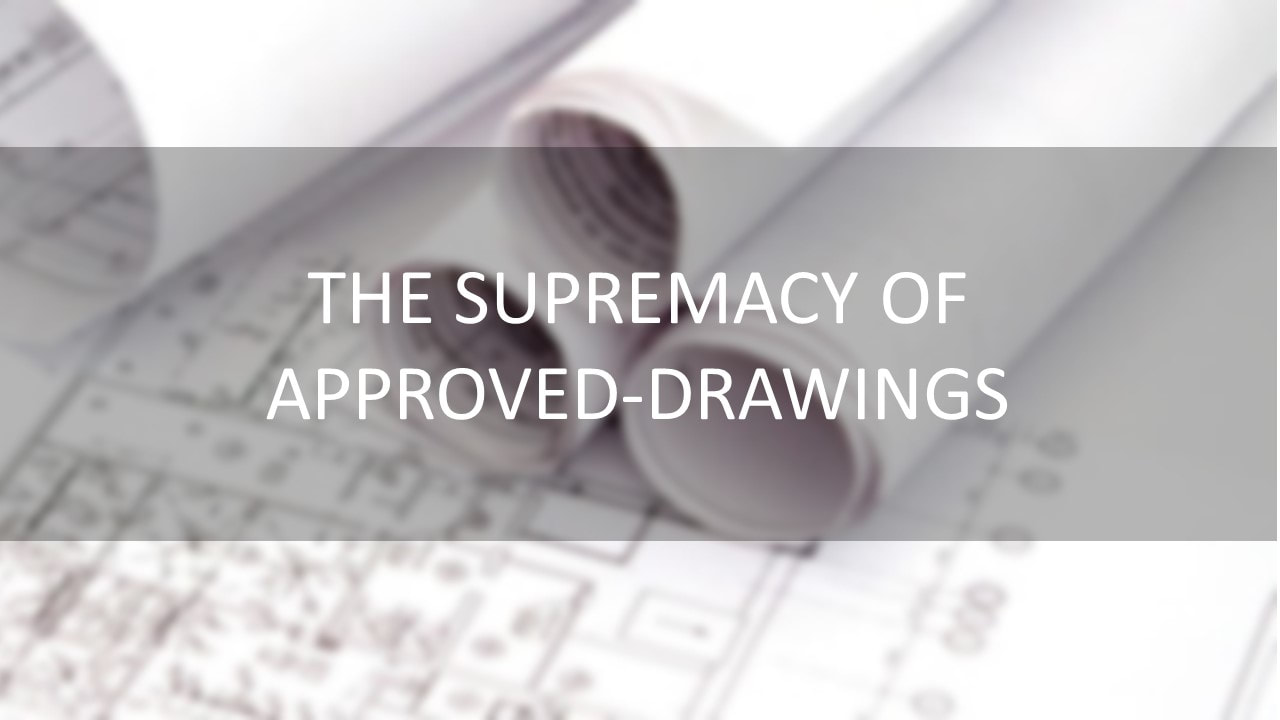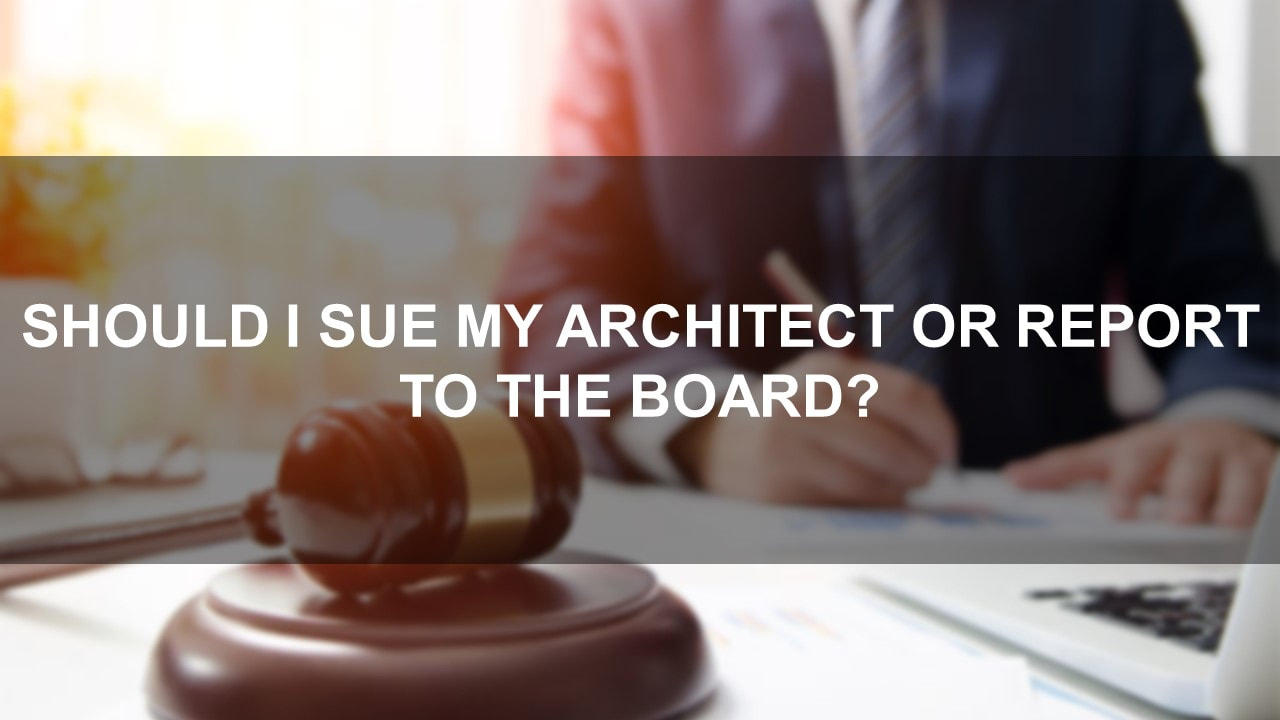THE SUPREMACY OF APPROVED-DRAWINGSThis writing is to guide QS, contractors and graduate-architects into understanding the various drawings…
In the profession of an architect, it is common to know that there are various issuance of drawings, originated from his office such as, Schematic-Drawings (sometimes called sketch-drawing), BP-Drawings, Bomba-Drawings, SPA-Drawings, Tender-Drawings, Construction-Drawings, Shop-Drawings and As-built Drawings. What are these exactly, or rather legally? There are three-statutory provisions that make a ‘drawing-legal’, means the architect will have to sign on it declaring, ‘certify that […] are in accordance to the UBBL 1984 and […] accept full responsibility’[1]. One, the Uniform Building Bylaws 1984 (UBBL), the Housing Development (Control and Licensing) Act 1966 (HDA) and the Contracts Act 1950. The moment the architect submitted his Schematic-Drawings for the consideration of the local authorities, including the fire-departments, these Schematic-Drawings had been elevated to become BP-Drawings and Bomba-Drawings, respectively. Both are construed as a ‘legal-document’ undertakings of liability by the architect to the public (authorities). Collectively, once ‘approved’ it is known as Approved-Drawings. Since it is an undertaking, it has to conform to every terms of the law, failing which the architect is liable for professional-negligence and misconduct, tantamount to criminal charges. That is the degree and gravity of compliance. The Approved-Drawings were to be translated into SPA-Drawings. In essence, it is supposed and legally should be an extract of the Approved-Drawings. In a nutshell, it is supposed to be the Approved-Drawings in manageable sizes to be inserted into the Sales and Purchase Agreement SPA between the Vendor and the House-buyer under the provision of the HDA. Therefore, it has no-further undertakings required by law, i.e. the HDA, thus, architect do not need to sign on it. The same Approved-Drawings were to be expended to include ‘blow-up’ detailing for the contractor to tender and thus, the name Tender-Drawings. As such it is the same Approved-Drawings and any significant changes will rendered the entire tender illegal and voidable-contract, ab-initio. A contract cannot be upheld if the nature of the contract is illegal, i.e. without the Approved-Drawings. On the same note, architect do not need to sign on these drawings. Similarly, when the contractor is appointed, the same Tender-Drawings must now, be elevated to be the Contract-Drawings and Construction-Drawings. Constructing a building with Construction-Drawings and contract-binding with Contract-Drawings that were differed from the Approved-Drawings will end up with colossal of contractual issues, not only to the contractor and employer but the vendor and its purchaser as well. Ultimately, to get strata-title, under the Strata Title Act 1985[2] and Strata Management Act 2013[3], the architect has to undertake that ‘the parcels constructed in accordance to the approved plans’. As-built Drawings that differed from Approved-Drawings are prima-facie of the architect ‘sleeping on the job’. Thus, you don’t need the architect to sign on the Contract-Drawings, As-built drawings and Construction-Drawings. Having said that, there is also something called the ‘Shop-Drawings’, and this ‘creature’ is not meant to be used as Construction-Drawings. Only ‘lazy-architect’ will use ‘shop-drawings’ as construction-drawings. It is also, illegal to append the Architect’s title-block in shop-drawings, simply because, it is not-prepared by him. It is prepared by specialist-contractors, manufacturers and generally, contractors. Why on earth must it contain the architect’s title-block? The correct application of shop-drawings is to be incorporated into the architect’s construction-drawings and not the other way around. Legally, contractor must not build based on drawings not specified as construction-drawings. As such, do you now, see how important is the Approved-Drawings? The only drawings that must be approved, be tendered and be built by it! Nothing else matter… Postscript: Vincent Tan wrote, ‘We found the contractors does not followed As-built drawing. Meaning what was supposed to be installed was not consistent with the As Built. Can the developer come back and say " we will amend the as built drawings" to make it consistent with actual site installation?’... this question required me to write more about ‘As-Built Drawings’. The meaning of ‘As-Built’ is a prima-facie of what has been built on site, itself an evidence if it does not reflect compliance to ‘Approved-Drawings’, it is entirely illegal and caused ripple across the myriad statutory obligations contravening these legislatures from UBBL 1984, HDA1996, STA 1964 to SMA 2013. It is common for the local authority to request the architect to submit ‘As-Built’ prior to CCC inspection, as a short-cut to amendment of Approved-Drawings. This has since rebuked in the ‘Highland Tower’ Case, where the court held that the practice of ‘As-Built’ is liked ‘holding ransom’ against the authorities compelling them to accept the ‘illegality’ wholesale, to make it legal. Thus, such unhealthy practices are still ‘rampant’. So, the answer to Vincent’s question is ‘Yes’ as developer can use ‘As-built’ to be ‘legalized’ by authorities, since they have the rights under UBBL to amend the ‘Approved-Drawings’ to reflect the ‘As-Built’. Thus, the practical use of the ‘As-Built’ is when an architect really needs to know an existing structure to work on it as renovation or makeover. --------------------------------------------------- [1] UBBL 1984, 2nd Sch. Form-A; s.6UBBL1984 [2] S.9(1)(b)(i): certified by professional architect [that] building constructed in accordance with [approved-plans] to which permission was given. [3] S.6(3)
2 Comments
SHOULD I SUE MY ARCHITECT OR REPORT TO THE BOARD?Two-occasions provided me inspiration for this writing. One, a situation where an-architect is challenging the-Institute over wrongful-removal on the register; two, a-question from my Graduate-Architect, preparing for her part-III (equivalent to RIBA-PartIII), with regard to disciplinary-action taken for Professional-misconduct. The issue may have been similar but the context is different. If ever, it can be a question in the Professional-Examination for LAM-PartIII, ‘Write a note to explain to your colleague, who has been called upon for disciplinary-action by the Board of Architect LAM, as pertaining to his defence, arising from his negligence act of providing a service under the Act’.
I reckoned that it is a little-unfair to pose such a question, aptly to be answered by a lawyer, but knowing the law is fundamental to the practice as an Architect, as the saying goes, the Architect is worth, not just by his drawing but by his ‘statutory-undertakings’ under the law, similar to that of other professions. The issues here are, whether can the-Board or the-Institute take actions against its member based on its inherent jurisdiction to interfere into its member’s right for livelihood? If so, whether a proper avenue for recourse is accorded to its member to be heard, as the bed-rock of ‘natural-justice’? If so, whether ‘misconduct’ has actually been breached when its member is yet to be found guilty of a crime in the court of competent jurisdiction? Finally, are the members of the committee or council of the-Board or the-Institute have immunity against any-claim by the members? Foremost, the background. The architect is a profession governs by the-Act[1] and such legislation provided for the setting up of the Board[2] to overlook the profession[3] of Architects and by annexure to the criteria of being a Professional-Architect[4] one has also a corporate-member[5] of the institute[6], a ‘social-club’ for learned-society, bearing no-statutory power. Secondly, the Malaysia-law provided for, the constitution[7] as the supreme-law of the land, hereinafter class-A; the-Act, with it provided for its-Rule[8], hereinafter class-B; the-Board’s discretion as in Order[9] and Circulars[10], hereinafter class-C; and the-Institute’s Advisory[11] and Rulings[12], hereinafter class-D. Thirdly, the Professional-liabilities as in professional-negligence and professional-misconduct. One has to bear in mind, professional-negligence does not equal professional-misconduct. Thus, what constitute professional-negligence and professional-misconduct? Can the-Board or the-Institute administer action pertaining to both? Whether can the-Board or the-Institute take actions against its member based on its inherent jurisdiction to interfere into its member’s right for livelihood? Legally, the-Board is the creature created by the-Act[13], within it, stipulated that it can take action against its member[14], only-its member[15], via the disciplinary-committee[16], subject to hearing[17] and right of representation[18], upon the recommendation[19] of the investigation-officer[20]; limited to only defined-misconducts[21]; including the act of ‘search and seizure’[22] by an ‘authorised-officer’[23], except with ‘lawful-authority’[24]; a subject of much-controversy. But when the ‘counter-claim’ was premised on its member’s right for livelihood, it is a ‘whole new-level’ of consideration, beyond the ambit of the-Board. It involves one, the question of conflict of law i.e. class-B versus class-A; two, the question of the ‘right-forum’ to hear the case with regard to an issue of conflict of law i.e. class-B versus class-A, ultimately, answering whether a proper avenue for recourse is accorded to its member to be heard, as the bed-rock of ‘natural-justice’? Foremost, the constituents of the disciplinary-committee go against the fundamental principle of ‘natural-justice’ to be heard in the court of competent jurisdiction. The question, are the constituents of the disciplinary-committee equal to the court of competent jurisdiction, i.e. the High-Court of the country? Whether the disciplinary-committee has the jurisdiction to hear matter pertaining to restriction of a member’s constitutional rights for the preservation of livelihood?[25] Careful reading of the misconducts is generally and mostly related to the matter of criminality, beyond the term of reference by the disciplinary-committee’s jurisdiction. General reading of the-Act, revealed as though the disciplinary-committee has a wide range of jurisdiction to decide upon its member’s fate. But in fact, the disciplinary-committee has only a very narrow jurisdiction. The correct way, is that the disciplinary-committee is to convict its member, only when the member is found guilty by the court of competent jurisdiction. The-Board cannot take actions against its member based on its inherent jurisdiction to interfere into its member’s right for livelihood, without the conviction from the court of competent jurisdiction. With such, there is an apparent conflict of law i.e. class-B versus class-A. With regard to the act of ‘search and seizure’ that can only be made lawful, by making a ‘police-report’, obtaining the relevant-warrant, prior to the act of ‘search and seizure’. Imagine if you have a situation of a ‘trigger-happy’ enforcing-officer, by each and every trade or professions, competing with the rest of the ‘law-enforcing’ personnel in the country, wouldn’t we revisit the era of the wild-wild west? Even ‘law-enforcing’ personnel requires a warrant to ‘search and seizure’. So, in reality, it is a provision good in theory, lousy in application. The-Institute with only, class-D jurisdiction, has no jurisdiction on this area. If so, whether a proper avenue for recourse is accorded to its member to be heard, as the bed-rock of ‘natural-justice’? The correct forum must commence in the court of competent jurisdiction, not the disciplinary-committee. The disciplinary-committee should under the recommendation of the investigation-officer pursue legal proceeding in the court of competent jurisdiction. Thereupon, conviction, shall the disciplinary-committee take remedial-action against the member. Whether ‘misconduct’ has actually been breached when its member is yet to be found guilty of a crime in the court of competent jurisdiction? Thus, in the same vein, the short-answer is no.[26] Another matter that is unusual is that appeal is only available via the appeal-board[27] only on a narrow matter pertaining to refusal or registration[28] and removal of registration[29]; taking into consideration that these matters interfere into its member’s right for livelihood; warrant that the appeal-board to be presided over by a High-Court Judge[30]. It means to say, any other matter not falling within these refusal or registration[31] and removal of registration[32] are not subject to appeal? As such, contravening ‘natural-justice’? Any difference if the matter of professional-misconduct be heard in the High-Court instead of the disciplinary-committee as it involves interference into its member’s right for livelihood, where the options of further appeal to the Appeal-Court and Federal-Court are available? The drafter of this Act is obviously aware of the gravity it involves and the limitation as to the jurisdiction of the disciplinary-committee. Finally, are the members of the committee or council of the-Board or the-Institute have immunity against any-claim by the members? Public-servant is accorded immunity against any cross-claims arising from negligence[33]. So, the question is, are the-Board and the disciplinary-committee, public-servants? Public services shall consist of the Federal and State General Public Service, the Joint Public Services, the Education Service, the Judiciary and the Legal Service and the Armed Forces.[34] For all intents and purpose, Statutory Bodies and the Local Authorities are also considered as parts of the Public Services. This is because both these autonomous bodies resemble the Public Services in many respects since they adopt the procedures of the Public Services pertaining to appointments, terms and conditions of service and the remuneration system.[35] Therefore, the-Board is a Statutory Bodies, its constituents[36] including that of the disciplinary-committee can be construed as public-servants, enjoying immunity in the context of ‘good-faith’[37]. However, that cannot be applied to members or councils of the-Institute, as they can sue and be sued, collectively and individually. However, a point has to be taken of the inherent nature of the ‘possibility of bias’ on account of the members of the-Board, the-Institute and the-disciplinary-committee, as they are appointed among the peers of practising professionals, whom by strictly to the law, are also ‘competitors’ in some cases, serving the same clients whom are limited in the industry and not from members of the public-servant whom are answerable to only the government. This is a domain for challenge in a sense of mala-fide. Concluding, what constitute professional-negligence and professional-misconduct? Can the-Board or the-Institute administer action pertaining to both? Professional-negligence, as in tort-liability has to be held by the court, not the-Board nor the-Institute. Whereas, professional-misconduct, as outlined by the-Act are illicit-commissions[38]; non-disclosure of conflict of interest[39], fraud/misrepresentation[40], any act of disgrace[41], non-compliance to the-Act[42], as to conditions of registration[43], procuring under fraudulent misrepresentation[44], concealing of facts to the disciplinary-committee[45], contravention of restriction[46], causes sufferings prior-registration[47], or post-registration[48], criminal-conviction[49], withdrawal of qualifications[50], unsound-mind[51] and bankruptcy[52] or incapacity[53]. These have nothing to do with professional-negligence. So, technically unsatisfied clients should not complaint to the-Board on matters of professional-negligence. Instead, they should just sue the architect in the court of competent jurisdiction. The-Board should only administer action pertaining to professional-misconduct, upon the conviction of the court. Whereas the-institute can only administer action upon the conviction of the-Board. Postscript: If the question of law is with regard to the matter of the-Institute alone, as a ‘social-club’ there is very little statutory-jurisdiction on the matter of professional-misconduct, especially so with the existence of the-Board. The-Institute shall not eclipse the-Board. -------------------------------------------------------------- [1] Architects Act 1963 (Amended 2015) [2] Board of Architect Malaysia (LAM) [3] S.4(1) Architects Act 1963 [4] Licensed to practice architecture, carries the title Ar., with post-nominal P.Arch, ALAM. [5] Being Associate of Pertubuhan Arkitek Malaysia APAM [6] Institute of Architects Malaysia (PAM) [7] The Federal Constitution of Malaysia 1957 [8] Architect Rules 1996 (Amended 2015) [9] LAM Disciplinary-Order [10] LAM-Circular [11] PAM-Advisory [12] As in PAM Arbitration-Rules and the sort [13] S.3(1) Architects Act 1963 [14] S.4(1)(c) Architects Act 1963 [15] S.7 Architects Act 1963 [16] S.15A(1)(b) Architects Act 1963 [17] S.6(a)(i) Architects Act 1963 [18] S.5(a)(ii) Architects Act 1963 [19] S.15A(5) Architects Act 1963 [20] S.15A(1)(a) Architects Act 1963 [21] S.15A(2) Architects Act 1963 [22] S.34B Architects Act 1963 [23] S.34B(1) Architects Act 1963 [24] S.34B(5) Architects Act 1963 [25] Article 5(1) Federal Constitution of Malaysia 1957 [26] Woolmington v DPP [1935] UKHL 1: presumption of innocence [27] S.28(2) Architects Act 1963 [28] S.28(1)(a) Architects Act 1963 [29] S.28(1)(b) Architects Act 1963 [30] S.29 Architects Act 1963 [31] S.28(1)(a) Architects Act 1963 [32] S.28(1)(b) Architects Act 1963 [33] Articles 132(3) and 160(2) Federal Constitution of Malaysia 1957 [34] Article 132 Federal Constitution of Malaysia 1957 [35] <https://en.wikipedia.org/wiki/Civil_service_in_Malaysia> [36] S.3(2) Architects Act 1963 [37] <https://www.thestar.com.my/news/nation/2014/04/12/high-court-public-servants-dont-have-immunity-from-lawsuits/> [38] S.15A(2)(a) Architects Act 1963 [39] S.15A(2)(b) Architects Act 1963 [40] S.15A(2)(c) Architects Act 1963 [41] S.15A(2)(d) Architects Act 1963 [42] S.15A(2)(e) Architects Act 1963 [43] S.15A(2)(f) Architects Act 1963 [44] S.15A(2)(g) Architects Act 1963 [45] S.15A(2)(h) Architects Act 1963 [46] S.15A(2)(i) Architects Act 1963 [47] S.15A(2)(j) Architects Act 1963 [48] S.15A(2)(k) Architects Act 1963 [49] S.15A(2)(l) Architects Act 1963 [50] S.15A(2)(m) Architects Act 1963 [51] S.15A(2)(n) Architects Act 1963 [52] S.15A(2)(o) Architects Act 1963 [53] S.15A(2)(p) Architects Act 1963 |
I am sharing these information with a caveat that these information is for educational purpose only and shall not be taken as an advice be it legal or otherwise. You should seek proper advice to your case with the relevant professionals. The author cannot guarantee the accuracy of the information so provided here.
Archives
March 2024
Categories
All
|
- Home
- About
-
Practice
-
DYA + C
-
Consultant
-
Educator
- Author I am...
- Speaking Engagement >
- Attempting Law School
- Journey in USM(Arch) >
- Discourse in Studio 6 >
-
d:KON 4
>
- Actors >
-
Acts
>
- Portraiture
- A Slice of Space Time
- Box of Installation of Lights
- Radio Misreading
- Grid of Destinies
- Shelter
- Anatomy of Pain
- Tensigrity of Ego
- Of Prisons and Walls
- Forest of Nails
- Curtain of Fears
- Dissolution of the Ego
- If it's Ain't Broken it's Ain't Worth Mending
- Flight of Freedom
- Cross of Complexity and Contradiction
- interrogation
- Stage >
- Play
- Approach
- Galleria >
- External Critique >
- Philosophy
- Codes Regulations & Standards >
- Photo Essays
- Contact





 RSS Feed
RSS Feed
